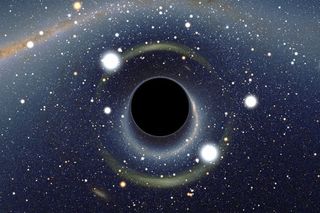Mysterious Signal Points to Monster Black Hole Merger

A mysterious light signal from a faraway galaxy could point to two supermassive black holes finishing up a merger in the galaxy's core, new research reveals.
Scientists saw repeating pulses from a quasar — a bright galactic core powered by at least one huge black hole — and say the light is likely being generated during the latter stages of a monster black hole collision.
If this interpretation is correct, researchers could learn a great deal more about the final phases of such mergers, where simulations tend to break down — a situation dubbed "the final parsec problem." [Black Holes of the Universe in Images]
The light signal from 3.5 billion light-years away was spotted by the Catalina Real-Time Transient Survey (CRTS), a set of three telescopes in Australia and the United States that look at 500 million light sources across 80 percent of the sky observable from Earth.
"There has never been a data set on quasar variability that approaches this scope before," lead study author George Djorgovski, director of the Center for Data-Driven Discovery at the California Institute of Technology, said in a statement.
"In the past, scientists who study the variability of quasars might only be able to follow some tens — or, at most, hundreds — of objects with a limited number of measurements," Djorgovski said in the statement. "In this case, we looked at a quarter-million quasars, and were able to gather a few hundred data points for each one."
The discovery came as a surprise, as the researchers were originally trying to learn more about how quasar brightness varies. While scrutinizing the data, however, they found 20 quasars that varied predictably — unlike the chaotic signals that researchers are used to.
Get the Space.com Newsletter
Breaking space news, the latest updates on rocket launches, skywatching events and more!
Further analysis showed that one quasar, called PG 1302-102, likely has two black holes separated by just a few hundredths of a light-year. Other mergers observed previously placed such colliding black holes much further apart — anywhere between tens and thousands of light-years.
To verify the signal, which appears to repeat every five years, researchers brought in historical information covering most of the last two decades. Also, the light spectrum revealed something interesting happening in the gases surrounding the disc, which are spinning so quickly that they get superheated.
"When you look at the emission lines in a spectrum from an object, what you're really seeing is information about speed — whether something is moving toward you or away from you and how fast. It's the Doppler effect," said co-author Eilat Glikman, an assistant professor of physics at Middlebury College in Vermont.

"With quasars, you typically have one emission line, and that line is a symmetric curve," Glikman added. "But with this quasar, it was necessary to add a second emission line with a slightly different speed than the first one in order to fit the data. That suggests something else, such as a second black hole, is perturbing this system."
Researchers aren't sure what is causing the repeating light signal, but possibilities could include jets of material rotating around the center, similar to a lighthouse, or a distorted disc of material around the black holes that is either throwing material on the black holes or "blocking light from the quasar at regular intervals," Glikman said.
The results of the research were reported Jan. 7 in the journal Nature.
Follow Elizabeth Howell @howellspace, or Space.com @Spacedotcom. We're also on Facebook and Google+. Original article on Space.com.
Join our Space Forums to keep talking space on the latest missions, night sky and more! And if you have a news tip, correction or comment, let us know at: community@space.com.

Elizabeth Howell (she/her), Ph.D., is a staff writer in the spaceflight channel since 2022 covering diversity, education and gaming as well. She was contributing writer for Space.com for 10 years before joining full-time. Elizabeth's reporting includes multiple exclusives with the White House and Office of the Vice-President of the United States, an exclusive conversation with aspiring space tourist (and NSYNC bassist) Lance Bass, speaking several times with the International Space Station, witnessing five human spaceflight launches on two continents, flying parabolic, working inside a spacesuit, and participating in a simulated Mars mission. Her latest book, "Why Am I Taller?", is co-written with astronaut Dave Williams. Elizabeth holds a Ph.D. and M.Sc. in Space Studies from the University of North Dakota, a Bachelor of Journalism from Canada's Carleton University and a Bachelor of History from Canada's Athabasca University. Elizabeth is also a post-secondary instructor in communications and science at several institutions since 2015; her experience includes developing and teaching an astronomy course at Canada's Algonquin College (with Indigenous content as well) to more than 1,000 students since 2020. Elizabeth first got interested in space after watching the movie Apollo 13 in 1996, and still wants to be an astronaut someday. Mastodon: https://qoto.org/@howellspace
Most Popular


